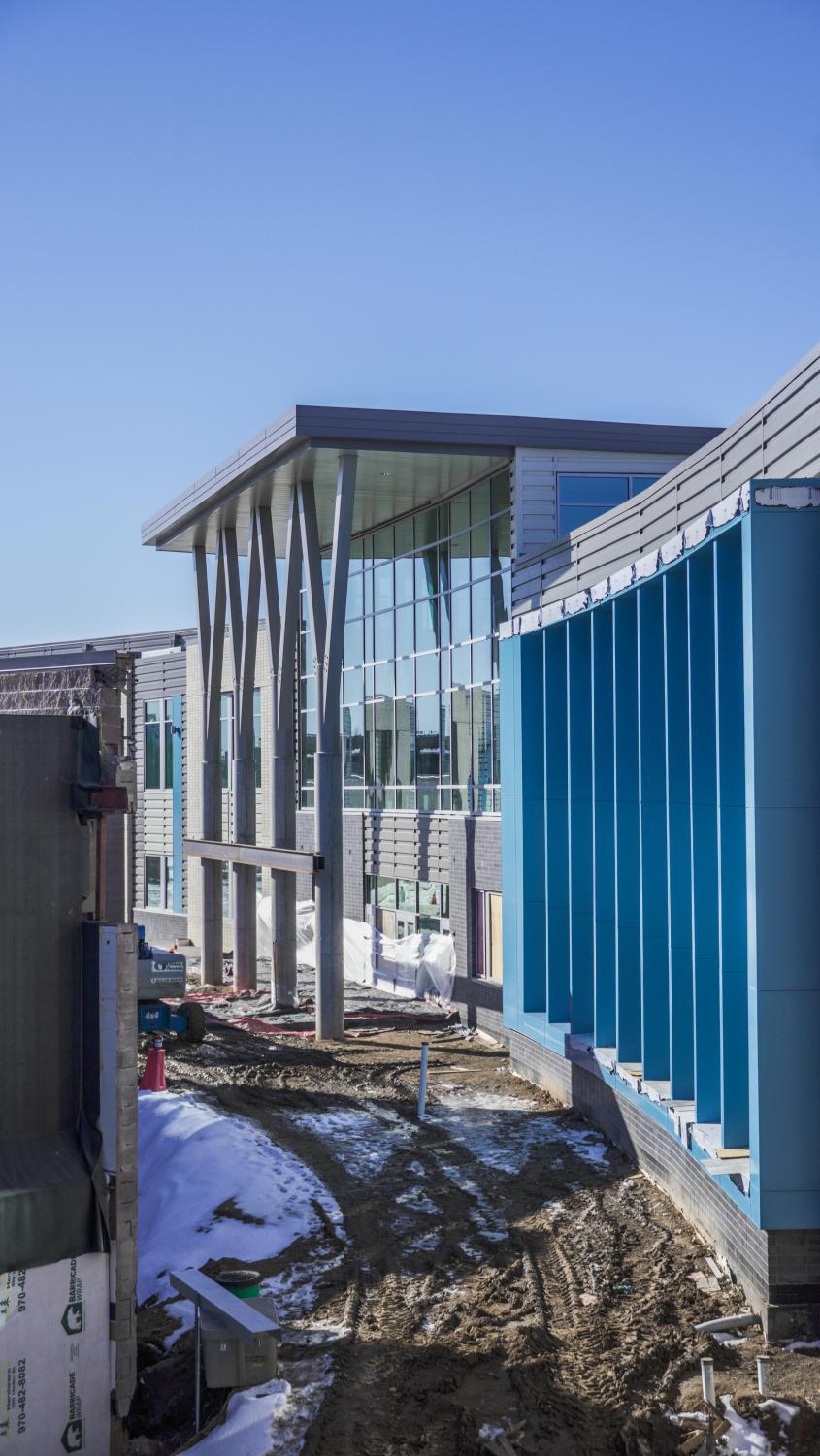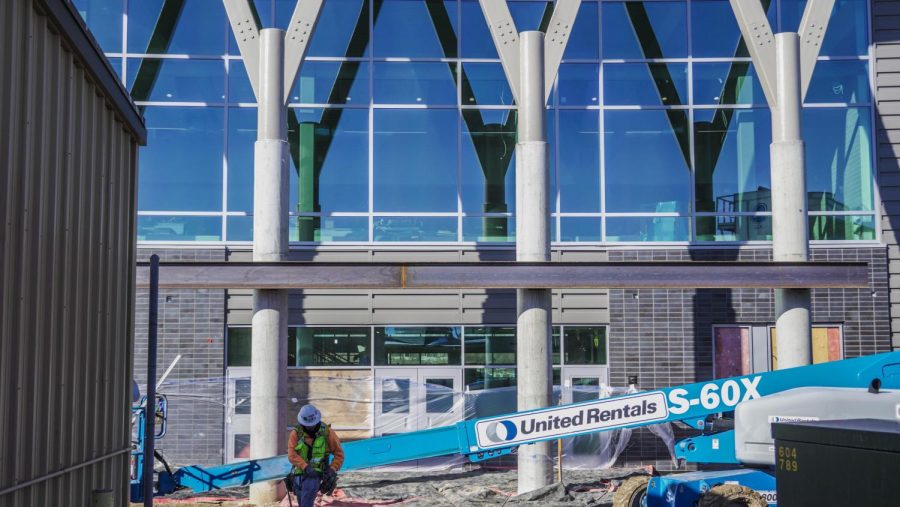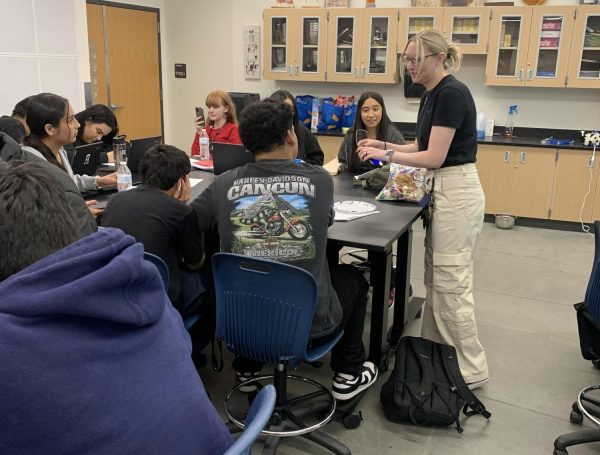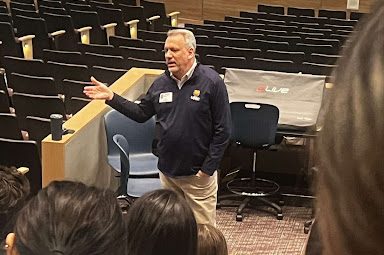Going Green: How will new facility be environmentally responsible?
A construction worker finishes up details outside of the new building on Tuesday morning. West’s building is beautiful, but is it sustainable?
February 8, 2022
A new building in the 21st Century comes with ripe opportunities for implementing green technologies and procedures. Greeley West High School’s multi-million dollar facility will take the environment into account somewhat, while leaving other opportunities for future students to do their part to combat climate change.
Matt Porta, the lead engineer for the new school, expressed his and the District 6’s goal for the new building. “We are designing this building so it doesn’t need to be torn down in 50 years. We want a building that can survive the test of time and not end up in the condition of the existing school,” Porta said.
With a school building sparing no expense to use quality materials and resources to ensure the school has a lasting impact, reducing the amount of waste produced from tearing down an existing building is crucial, such as the current West. With most of the present building void from being recycled and reused, the waste has a considerable impact on the environment.

With 21st-century technology advancing, this is a chance to implement energy-saving features to reduce the carbon footprint of the new school. The design team extensively considered these factors. With radiant heating warming the building through the floors, it has been proven that using liquid coolant more effectively heats a building. This is one concept the designers wanted to follow for the new school.
“We want to keep the school an envelope, making sure there is no leakage, and ensure the energy being used for heating and cooling stays within the building. This means vast amounts of insulation, which allows the cooling and heating system to be smaller, using less energy,” Porta stated.
There is also a use of light sensors that will decrease the amount of artificial light if there is excess sunlight. With the school technically a “greenhouse” with a considerable amount of windows, the use of artificial light will be significantly reduced from the current school.
Coupling the energy efficiency of the heating and cooling systems, the amount of insulation, and the low use of artificial light, the energy efficiency of the new building will be far more efficient and advanced than any school within the district.
However, the new school is still very reliant on fossil fuels and the district had no consideration of using green alternatives, “In the planning process, green energy was never a priority,” Eric Soerger, the lead mechanical engineer for the new school, explained. “Especially (in regards to) the district to be producing their own energy. However, there is certainly roof area to add solar panels in the future,” Stoerger added.
With plans of the new building not incorporating green energy, some students believe this is a missed opportunity to educate students about climate change and step in the right direction towards zero emissions.
“Our main priority was not making the building green, it was making sure each student gets a quality education in a comfortable environment,” senior International Baccalaureate student Jose Aguina said. “I do believe that this is a missed opportunity to implement green energy.”
Aguina thinks that the staff and students will ultimately make a green change on their own. “I think students and teachers can take the programs and build upon them to help make the building green, and since we already spent so much money on it, there should be some benefits to that in helping the environment and our community.”
In Steamboat Springs, Sleeping Giant – a pre-kindergarten-8th grade school built in August of 2021 – has taken a different approach. Designed by the same architect company as the new Greeley West, Hord Coplan Macht, they decided to implement green technologies within their building.
“Our building has some amazing sustainable features,” assistant principal of Sleeping Giant, Karen Draper said, “Along with our large array of solar panels, we also have the first system of extremely low voltage lighting in Colorado.”
The school also takes it upon themselves to educate their students on the topic of climate change, using their own green technology to demonstrate their use and importance in schools and buildings worldwide. “Our sixth, seventh, and eight graders meet with the Yampa Valley Sustainability Council, along with demonstrating their knowledge of sustainability through projects and presentations,” said Draper.
Within colleges and universities, many actions are being taken as well, such as the University of Northern Colorado which is currently undergoing a $500,000 solar panel installation. They also have a widespread recycling program, something Greeley West has struggled with for years.
Students are also a significant part of the climate change movement, and at UNC they have a dedicated student advocacy group called LEAF which implements climate aiding technologies and educates students on campus about steps towards a greener campus and a carbon-free life.
Even though the new Greeley West won’t receive a substantial upgrade in climate benefiting technology, this calls for future Spartans to take it upon themselves in order to better equip the building for a carbon-neutral environment. This could be things such as implementing a better recycling program, teaching students about the dangers, planting trees, or even raising funds to put solar panels and other green energy-producing technologies into place.
Principal Jeff Cranson said all of that is on the table. “I believe the education system plays an important role in the large piece of climate change,” Cranson said. “But it is all about the society and its willingness to change. There are many factors that play into this such as politics and the community. Unfortunately, our community in Weld County isn’t ready for that transition, but students are the future of this change and in the new building they can help make a difference in years to come.”












